Report on HSBC: Strategy, Change Management, Market Share, and PESTLE
VerifiedAdded on 2023/06/15
|13
|3676
|139
Report
AI Summary
This report provides a comprehensive analysis of HSBC's market share, strategic planning, and change management processes. It examines the impact of COVID-19 on the bank's operations and its commitment to net-zero sustainability. The report utilizes William's strategy management model, the McKinsey 7-S model, and PESTLE analysis to assess HSBC's internal and external environments. Furthermore, it includes a competitive analysis using Porter's Five Forces model, highlighting the opportunities and threats faced by the company. The analysis covers HSBC's market size, fintech adoption, and the strategic approaches employed to maintain a competitive edge in the financial services industry. Key areas of focus include the bank's online service offerings, organizational structure, financial systems, and leadership style, all contributing to a holistic understanding of HSBC's strategic positioning and operational effectiveness.

Strategy and Change
Management
Management
Paraphrase This Document
Need a fresh take? Get an instant paraphrase of this document with our AI Paraphraser
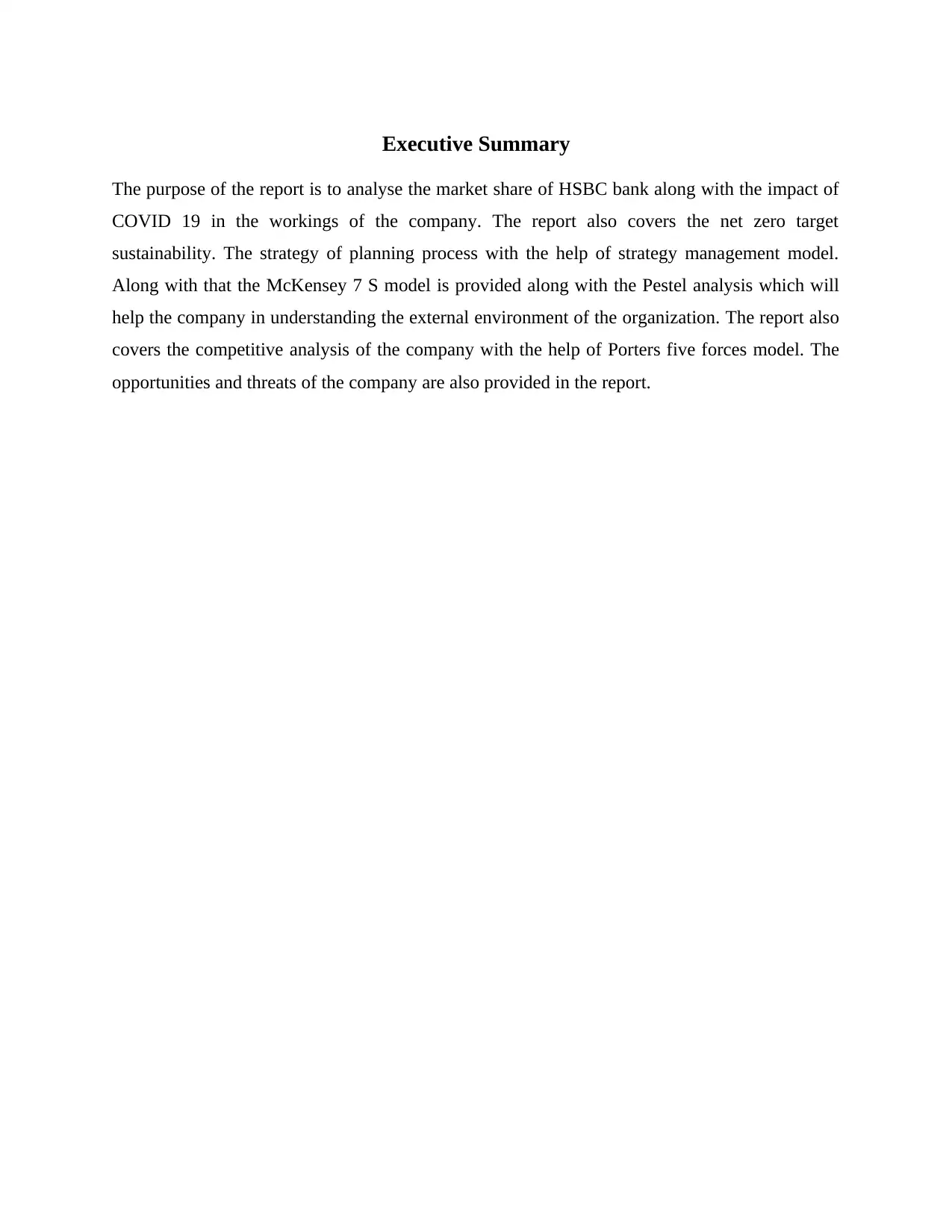
Executive Summary
The purpose of the report is to analyse the market share of HSBC bank along with the impact of
COVID 19 in the workings of the company. The report also covers the net zero target
sustainability. The strategy of planning process with the help of strategy management model.
Along with that the McKensey 7 S model is provided along with the Pestel analysis which will
help the company in understanding the external environment of the organization. The report also
covers the competitive analysis of the company with the help of Porters five forces model. The
opportunities and threats of the company are also provided in the report.
The purpose of the report is to analyse the market share of HSBC bank along with the impact of
COVID 19 in the workings of the company. The report also covers the net zero target
sustainability. The strategy of planning process with the help of strategy management model.
Along with that the McKensey 7 S model is provided along with the Pestel analysis which will
help the company in understanding the external environment of the organization. The report also
covers the competitive analysis of the company with the help of Porters five forces model. The
opportunities and threats of the company are also provided in the report.
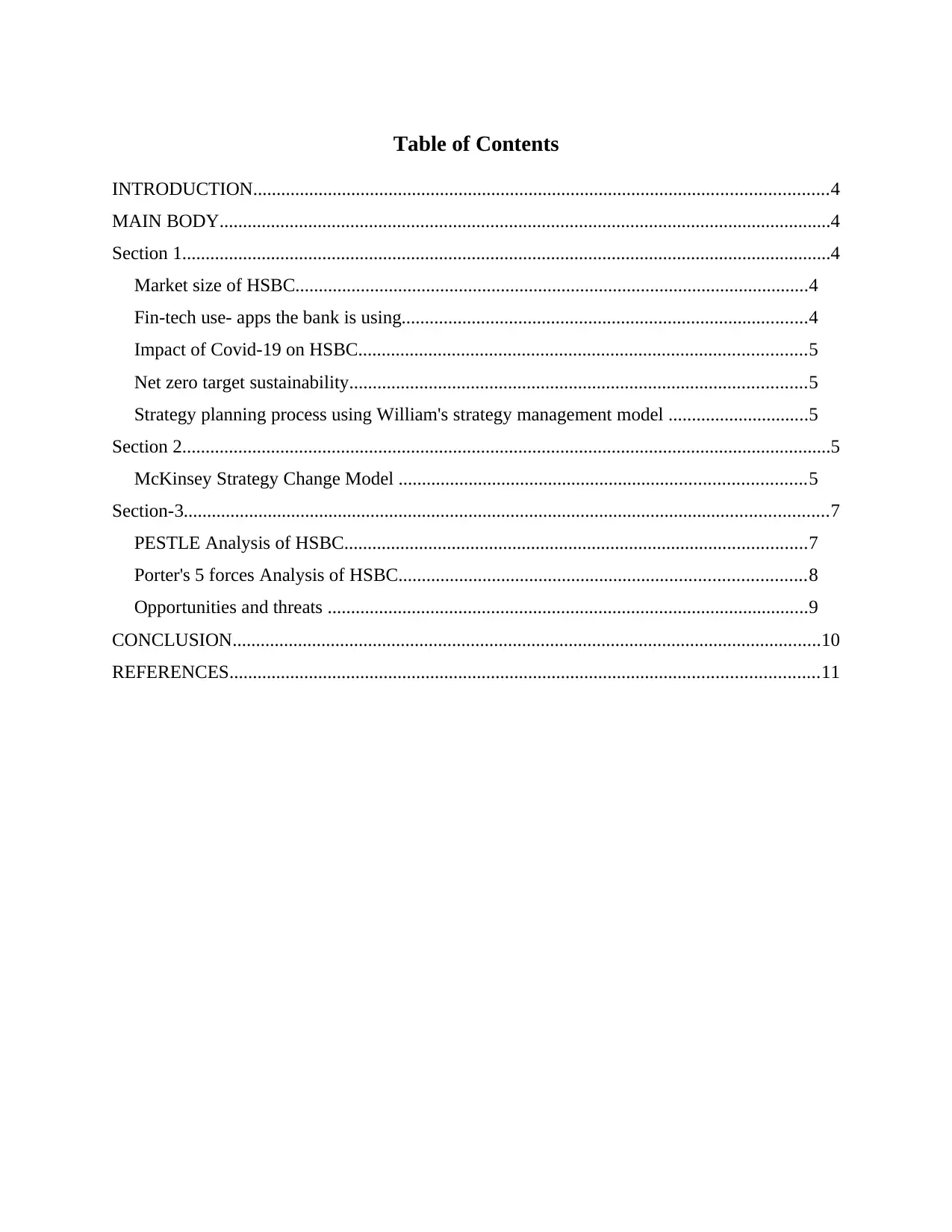
Table of Contents
INTRODUCTION...........................................................................................................................4
MAIN BODY...................................................................................................................................4
Section 1...........................................................................................................................................4
Market size of HSBC..............................................................................................................4
Fin-tech use- apps the bank is using.......................................................................................4
Impact of Covid-19 on HSBC................................................................................................5
Net zero target sustainability..................................................................................................5
Strategy planning process using William's strategy management model ..............................5
Section 2...........................................................................................................................................5
McKinsey Strategy Change Model .......................................................................................5
Section-3..........................................................................................................................................7
PESTLE Analysis of HSBC...................................................................................................7
Porter's 5 forces Analysis of HSBC.......................................................................................8
Opportunities and threats .......................................................................................................9
CONCLUSION..............................................................................................................................10
REFERENCES..............................................................................................................................11
INTRODUCTION...........................................................................................................................4
MAIN BODY...................................................................................................................................4
Section 1...........................................................................................................................................4
Market size of HSBC..............................................................................................................4
Fin-tech use- apps the bank is using.......................................................................................4
Impact of Covid-19 on HSBC................................................................................................5
Net zero target sustainability..................................................................................................5
Strategy planning process using William's strategy management model ..............................5
Section 2...........................................................................................................................................5
McKinsey Strategy Change Model .......................................................................................5
Section-3..........................................................................................................................................7
PESTLE Analysis of HSBC...................................................................................................7
Porter's 5 forces Analysis of HSBC.......................................................................................8
Opportunities and threats .......................................................................................................9
CONCLUSION..............................................................................................................................10
REFERENCES..............................................................................................................................11
⊘ This is a preview!⊘
Do you want full access?
Subscribe today to unlock all pages.

Trusted by 1+ million students worldwide
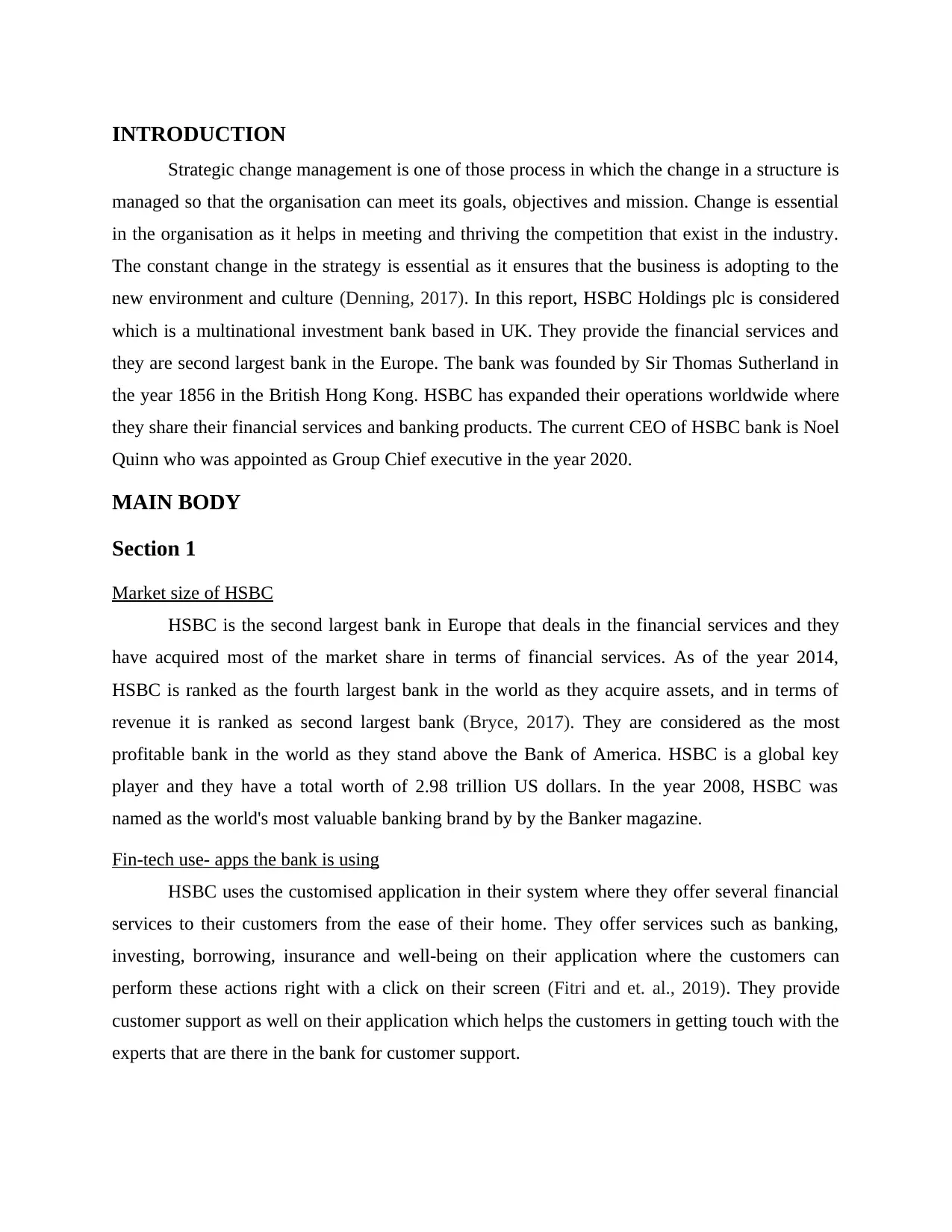
INTRODUCTION
Strategic change management is one of those process in which the change in a structure is
managed so that the organisation can meet its goals, objectives and mission. Change is essential
in the organisation as it helps in meeting and thriving the competition that exist in the industry.
The constant change in the strategy is essential as it ensures that the business is adopting to the
new environment and culture (Denning, 2017). In this report, HSBC Holdings plc is considered
which is a multinational investment bank based in UK. They provide the financial services and
they are second largest bank in the Europe. The bank was founded by Sir Thomas Sutherland in
the year 1856 in the British Hong Kong. HSBC has expanded their operations worldwide where
they share their financial services and banking products. The current CEO of HSBC bank is Noel
Quinn who was appointed as Group Chief executive in the year 2020.
MAIN BODY
Section 1
Market size of HSBC
HSBC is the second largest bank in Europe that deals in the financial services and they
have acquired most of the market share in terms of financial services. As of the year 2014,
HSBC is ranked as the fourth largest bank in the world as they acquire assets, and in terms of
revenue it is ranked as second largest bank (Bryce, 2017). They are considered as the most
profitable bank in the world as they stand above the Bank of America. HSBC is a global key
player and they have a total worth of 2.98 trillion US dollars. In the year 2008, HSBC was
named as the world's most valuable banking brand by by the Banker magazine.
Fin-tech use- apps the bank is using
HSBC uses the customised application in their system where they offer several financial
services to their customers from the ease of their home. They offer services such as banking,
investing, borrowing, insurance and well-being on their application where the customers can
perform these actions right with a click on their screen (Fitri and et. al., 2019). They provide
customer support as well on their application which helps the customers in getting touch with the
experts that are there in the bank for customer support.
Strategic change management is one of those process in which the change in a structure is
managed so that the organisation can meet its goals, objectives and mission. Change is essential
in the organisation as it helps in meeting and thriving the competition that exist in the industry.
The constant change in the strategy is essential as it ensures that the business is adopting to the
new environment and culture (Denning, 2017). In this report, HSBC Holdings plc is considered
which is a multinational investment bank based in UK. They provide the financial services and
they are second largest bank in the Europe. The bank was founded by Sir Thomas Sutherland in
the year 1856 in the British Hong Kong. HSBC has expanded their operations worldwide where
they share their financial services and banking products. The current CEO of HSBC bank is Noel
Quinn who was appointed as Group Chief executive in the year 2020.
MAIN BODY
Section 1
Market size of HSBC
HSBC is the second largest bank in Europe that deals in the financial services and they
have acquired most of the market share in terms of financial services. As of the year 2014,
HSBC is ranked as the fourth largest bank in the world as they acquire assets, and in terms of
revenue it is ranked as second largest bank (Bryce, 2017). They are considered as the most
profitable bank in the world as they stand above the Bank of America. HSBC is a global key
player and they have a total worth of 2.98 trillion US dollars. In the year 2008, HSBC was
named as the world's most valuable banking brand by by the Banker magazine.
Fin-tech use- apps the bank is using
HSBC uses the customised application in their system where they offer several financial
services to their customers from the ease of their home. They offer services such as banking,
investing, borrowing, insurance and well-being on their application where the customers can
perform these actions right with a click on their screen (Fitri and et. al., 2019). They provide
customer support as well on their application which helps the customers in getting touch with the
experts that are there in the bank for customer support.
Paraphrase This Document
Need a fresh take? Get an instant paraphrase of this document with our AI Paraphraser

Impact of Covid-19 on HSBC
Profitability and the credit management are the areas that are impacted as the low interest
rate scenario in the market was somehow impacting the profitability of the business.
High volatility in the stock market is one of those areas due to which the overall
operations of the business were impacted and the bank valuations were constantly
dropping.
The customer relationship was somehow impacted due to Covid-19 as the crisis directly
impacted the economy and the banks were actually facing gaps in the services that they
provide to the customers.
Net zero target sustainability
HSBC is one of those banks that prioritise investment and financing that supports the
transition into a net zero economy of the worldwide. The plan of the bank is to reduced the
activities of financial emission from the portfolio of the customers by the year 2050 or sooner.
Strategy planning process using William's strategy management model
William F Glueck developed several methods than can be used in the general decision
making process. The phases that is used in this model are discussed below: Strategic management elements- This element helps the organisation in determining the
goals, missions and values that the firm need to accomplish in the firm(Carayannis,
2018). Analysis and diagnosis- This phase helps in searching the environment and impact that
the threats and opportunities that the business go through. Choice- This phase helps in considering the alternative and assuring that the business is
applying appropriate strategy.
Implementation- This phase involves the plans, policies, structure, resources and
administrative style and these things should match with the strategies that are being
implemented in the business.
Section 2
McKinsey Strategy Change Model
McKinsey model is one of the framework that is used in the organisation to bring
effectiveness and further the seven factors are needed to align so that the they can get
Profitability and the credit management are the areas that are impacted as the low interest
rate scenario in the market was somehow impacting the profitability of the business.
High volatility in the stock market is one of those areas due to which the overall
operations of the business were impacted and the bank valuations were constantly
dropping.
The customer relationship was somehow impacted due to Covid-19 as the crisis directly
impacted the economy and the banks were actually facing gaps in the services that they
provide to the customers.
Net zero target sustainability
HSBC is one of those banks that prioritise investment and financing that supports the
transition into a net zero economy of the worldwide. The plan of the bank is to reduced the
activities of financial emission from the portfolio of the customers by the year 2050 or sooner.
Strategy planning process using William's strategy management model
William F Glueck developed several methods than can be used in the general decision
making process. The phases that is used in this model are discussed below: Strategic management elements- This element helps the organisation in determining the
goals, missions and values that the firm need to accomplish in the firm(Carayannis,
2018). Analysis and diagnosis- This phase helps in searching the environment and impact that
the threats and opportunities that the business go through. Choice- This phase helps in considering the alternative and assuring that the business is
applying appropriate strategy.
Implementation- This phase involves the plans, policies, structure, resources and
administrative style and these things should match with the strategies that are being
implemented in the business.
Section 2
McKinsey Strategy Change Model
McKinsey model is one of the framework that is used in the organisation to bring
effectiveness and further the seven factors are needed to align so that the they can get
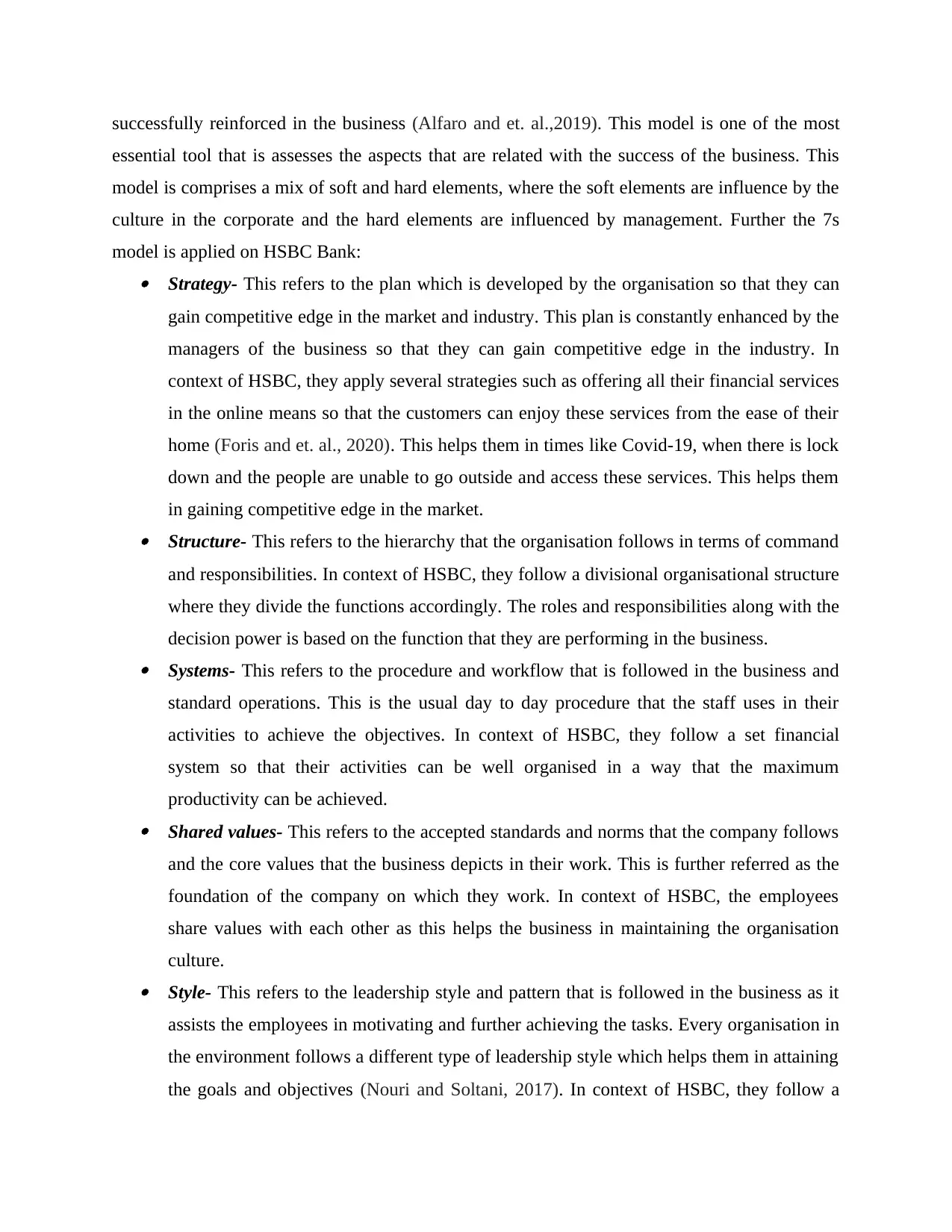
successfully reinforced in the business (Alfaro and et. al.,2019). This model is one of the most
essential tool that is assesses the aspects that are related with the success of the business. This
model is comprises a mix of soft and hard elements, where the soft elements are influence by the
culture in the corporate and the hard elements are influenced by management. Further the 7s
model is applied on HSBC Bank: Strategy- This refers to the plan which is developed by the organisation so that they can
gain competitive edge in the market and industry. This plan is constantly enhanced by the
managers of the business so that they can gain competitive edge in the industry. In
context of HSBC, they apply several strategies such as offering all their financial services
in the online means so that the customers can enjoy these services from the ease of their
home (Foris and et. al., 2020). This helps them in times like Covid-19, when there is lock
down and the people are unable to go outside and access these services. This helps them
in gaining competitive edge in the market. Structure- This refers to the hierarchy that the organisation follows in terms of command
and responsibilities. In context of HSBC, they follow a divisional organisational structure
where they divide the functions accordingly. The roles and responsibilities along with the
decision power is based on the function that they are performing in the business. Systems- This refers to the procedure and workflow that is followed in the business and
standard operations. This is the usual day to day procedure that the staff uses in their
activities to achieve the objectives. In context of HSBC, they follow a set financial
system so that their activities can be well organised in a way that the maximum
productivity can be achieved. Shared values- This refers to the accepted standards and norms that the company follows
and the core values that the business depicts in their work. This is further referred as the
foundation of the company on which they work. In context of HSBC, the employees
share values with each other as this helps the business in maintaining the organisation
culture. Style- This refers to the leadership style and pattern that is followed in the business as it
assists the employees in motivating and further achieving the tasks. Every organisation in
the environment follows a different type of leadership style which helps them in attaining
the goals and objectives (Nouri and Soltani, 2017). In context of HSBC, they follow a
essential tool that is assesses the aspects that are related with the success of the business. This
model is comprises a mix of soft and hard elements, where the soft elements are influence by the
culture in the corporate and the hard elements are influenced by management. Further the 7s
model is applied on HSBC Bank: Strategy- This refers to the plan which is developed by the organisation so that they can
gain competitive edge in the market and industry. This plan is constantly enhanced by the
managers of the business so that they can gain competitive edge in the industry. In
context of HSBC, they apply several strategies such as offering all their financial services
in the online means so that the customers can enjoy these services from the ease of their
home (Foris and et. al., 2020). This helps them in times like Covid-19, when there is lock
down and the people are unable to go outside and access these services. This helps them
in gaining competitive edge in the market. Structure- This refers to the hierarchy that the organisation follows in terms of command
and responsibilities. In context of HSBC, they follow a divisional organisational structure
where they divide the functions accordingly. The roles and responsibilities along with the
decision power is based on the function that they are performing in the business. Systems- This refers to the procedure and workflow that is followed in the business and
standard operations. This is the usual day to day procedure that the staff uses in their
activities to achieve the objectives. In context of HSBC, they follow a set financial
system so that their activities can be well organised in a way that the maximum
productivity can be achieved. Shared values- This refers to the accepted standards and norms that the company follows
and the core values that the business depicts in their work. This is further referred as the
foundation of the company on which they work. In context of HSBC, the employees
share values with each other as this helps the business in maintaining the organisation
culture. Style- This refers to the leadership style and pattern that is followed in the business as it
assists the employees in motivating and further achieving the tasks. Every organisation in
the environment follows a different type of leadership style which helps them in attaining
the goals and objectives (Nouri and Soltani, 2017). In context of HSBC, they follow a
⊘ This is a preview!⊘
Do you want full access?
Subscribe today to unlock all pages.

Trusted by 1+ million students worldwide

transformational leadership style where the employees are motivated to bring a positive
change in the organisation through innovative set of ideas. Skills- This refers to the required skills that the employees of the company must have in
order to attain the set goals. The skills that the employees have must be relevant to the job
and the tasks that they are assigned (Demir and et. al., 2017). In context of HSBC, their
employees should have knowledge of financial aspects and further the employees should
have relevant knowledge to the tasks as this helps the business in fulfilling the goals. Staff- The people who work in the company are the biggest resource of any institution
and further the employees should be treated with respect so that they feel valued in the
company. This will help in increasing the performance of the company as the employees
will give their best in the activities and functions that they are performing. In context of
HSBC, they hire people who are fully qualified of the job that they are applying for a
they are very particular about the quality of work that is assigned to them.
Section-3
PESTLE Analysis of HSBC
PESTLE analysis is one of the tool that is used in the business to analyse the macro that
is the external environment in which the business exist and how they impact the operations of the
business. Further the PESTLE analysis of HSBC is discussed below: Political factors- These are the factors that are related with the government intervention
such as policies, restrictions and tariffs. HSBC is one of the financial institution which
gets majorly impacted by the actions of the government. The regulations that are implied
by the financial regulating body of UK impacts the operations such as interest rate and
such several factors. Economic factors- This refers to the factors that are related with the economy of the
country in which the business is operating. The economy is one of the major driver in
case of financial institutions as the activities such as interest rate, lending rate and other
financial aspects are based on the economy (Dalisova and et. al., 2020). If the economy is
booming then it will positively impact HSBC and in case the economy is struggling then
this will negatively impact the business.
change in the organisation through innovative set of ideas. Skills- This refers to the required skills that the employees of the company must have in
order to attain the set goals. The skills that the employees have must be relevant to the job
and the tasks that they are assigned (Demir and et. al., 2017). In context of HSBC, their
employees should have knowledge of financial aspects and further the employees should
have relevant knowledge to the tasks as this helps the business in fulfilling the goals. Staff- The people who work in the company are the biggest resource of any institution
and further the employees should be treated with respect so that they feel valued in the
company. This will help in increasing the performance of the company as the employees
will give their best in the activities and functions that they are performing. In context of
HSBC, they hire people who are fully qualified of the job that they are applying for a
they are very particular about the quality of work that is assigned to them.
Section-3
PESTLE Analysis of HSBC
PESTLE analysis is one of the tool that is used in the business to analyse the macro that
is the external environment in which the business exist and how they impact the operations of the
business. Further the PESTLE analysis of HSBC is discussed below: Political factors- These are the factors that are related with the government intervention
such as policies, restrictions and tariffs. HSBC is one of the financial institution which
gets majorly impacted by the actions of the government. The regulations that are implied
by the financial regulating body of UK impacts the operations such as interest rate and
such several factors. Economic factors- This refers to the factors that are related with the economy of the
country in which the business is operating. The economy is one of the major driver in
case of financial institutions as the activities such as interest rate, lending rate and other
financial aspects are based on the economy (Dalisova and et. al., 2020). If the economy is
booming then it will positively impact HSBC and in case the economy is struggling then
this will negatively impact the business.
Paraphrase This Document
Need a fresh take? Get an instant paraphrase of this document with our AI Paraphraser
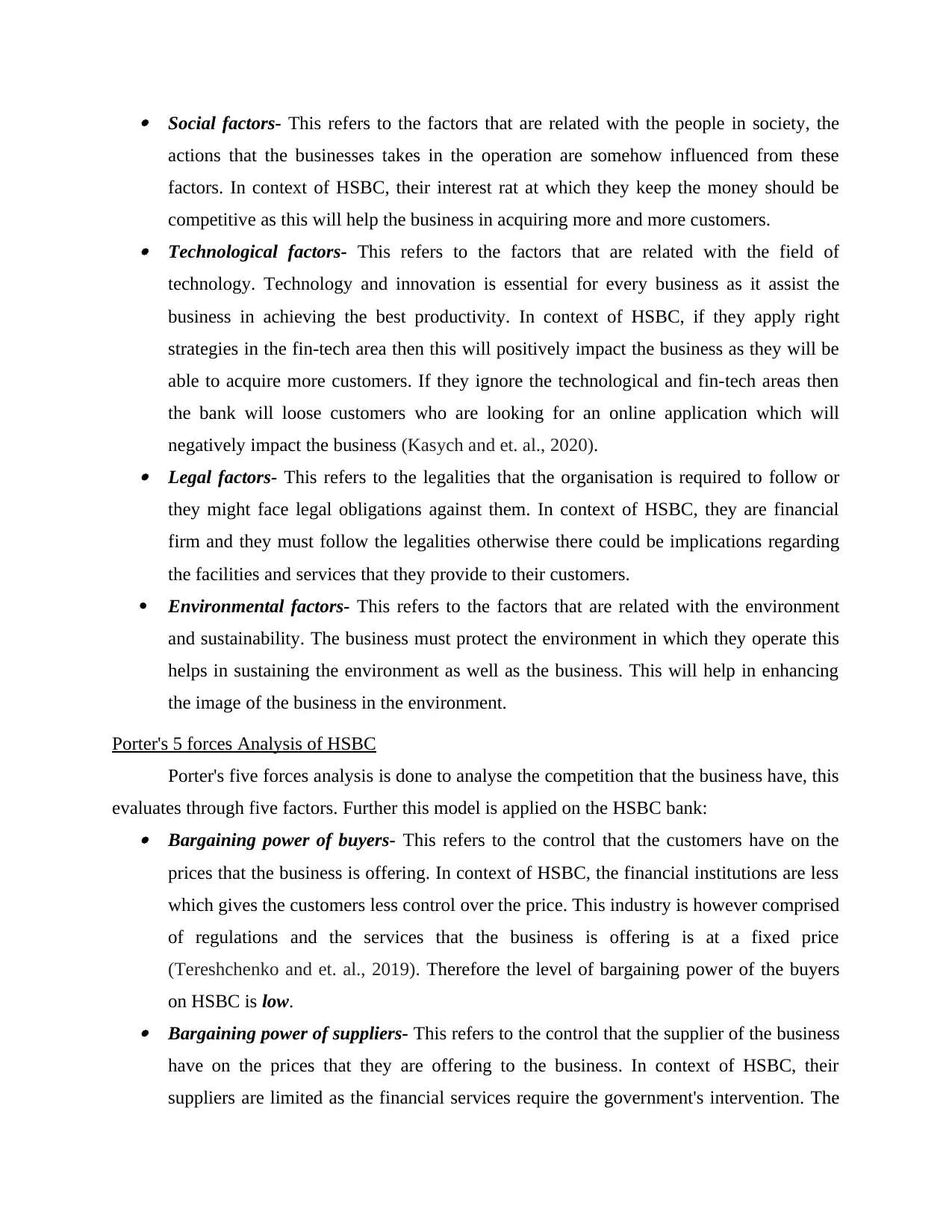
Social factors- This refers to the factors that are related with the people in society, the
actions that the businesses takes in the operation are somehow influenced from these
factors. In context of HSBC, their interest rat at which they keep the money should be
competitive as this will help the business in acquiring more and more customers. Technological factors- This refers to the factors that are related with the field of
technology. Technology and innovation is essential for every business as it assist the
business in achieving the best productivity. In context of HSBC, if they apply right
strategies in the fin-tech area then this will positively impact the business as they will be
able to acquire more customers. If they ignore the technological and fin-tech areas then
the bank will loose customers who are looking for an online application which will
negatively impact the business (Kasych and et. al., 2020). Legal factors- This refers to the legalities that the organisation is required to follow or
they might face legal obligations against them. In context of HSBC, they are financial
firm and they must follow the legalities otherwise there could be implications regarding
the facilities and services that they provide to their customers.
Environmental factors- This refers to the factors that are related with the environment
and sustainability. The business must protect the environment in which they operate this
helps in sustaining the environment as well as the business. This will help in enhancing
the image of the business in the environment.
Porter's 5 forces Analysis of HSBC
Porter's five forces analysis is done to analyse the competition that the business have, this
evaluates through five factors. Further this model is applied on the HSBC bank: Bargaining power of buyers- This refers to the control that the customers have on the
prices that the business is offering. In context of HSBC, the financial institutions are less
which gives the customers less control over the price. This industry is however comprised
of regulations and the services that the business is offering is at a fixed price
(Tereshchenko and et. al., 2019). Therefore the level of bargaining power of the buyers
on HSBC is low. Bargaining power of suppliers- This refers to the control that the supplier of the business
have on the prices that they are offering to the business. In context of HSBC, their
suppliers are limited as the financial services require the government's intervention. The
actions that the businesses takes in the operation are somehow influenced from these
factors. In context of HSBC, their interest rat at which they keep the money should be
competitive as this will help the business in acquiring more and more customers. Technological factors- This refers to the factors that are related with the field of
technology. Technology and innovation is essential for every business as it assist the
business in achieving the best productivity. In context of HSBC, if they apply right
strategies in the fin-tech area then this will positively impact the business as they will be
able to acquire more customers. If they ignore the technological and fin-tech areas then
the bank will loose customers who are looking for an online application which will
negatively impact the business (Kasych and et. al., 2020). Legal factors- This refers to the legalities that the organisation is required to follow or
they might face legal obligations against them. In context of HSBC, they are financial
firm and they must follow the legalities otherwise there could be implications regarding
the facilities and services that they provide to their customers.
Environmental factors- This refers to the factors that are related with the environment
and sustainability. The business must protect the environment in which they operate this
helps in sustaining the environment as well as the business. This will help in enhancing
the image of the business in the environment.
Porter's 5 forces Analysis of HSBC
Porter's five forces analysis is done to analyse the competition that the business have, this
evaluates through five factors. Further this model is applied on the HSBC bank: Bargaining power of buyers- This refers to the control that the customers have on the
prices that the business is offering. In context of HSBC, the financial institutions are less
which gives the customers less control over the price. This industry is however comprised
of regulations and the services that the business is offering is at a fixed price
(Tereshchenko and et. al., 2019). Therefore the level of bargaining power of the buyers
on HSBC is low. Bargaining power of suppliers- This refers to the control that the supplier of the business
have on the prices that they are offering to the business. In context of HSBC, their
suppliers are limited as the financial services require the government's intervention. The
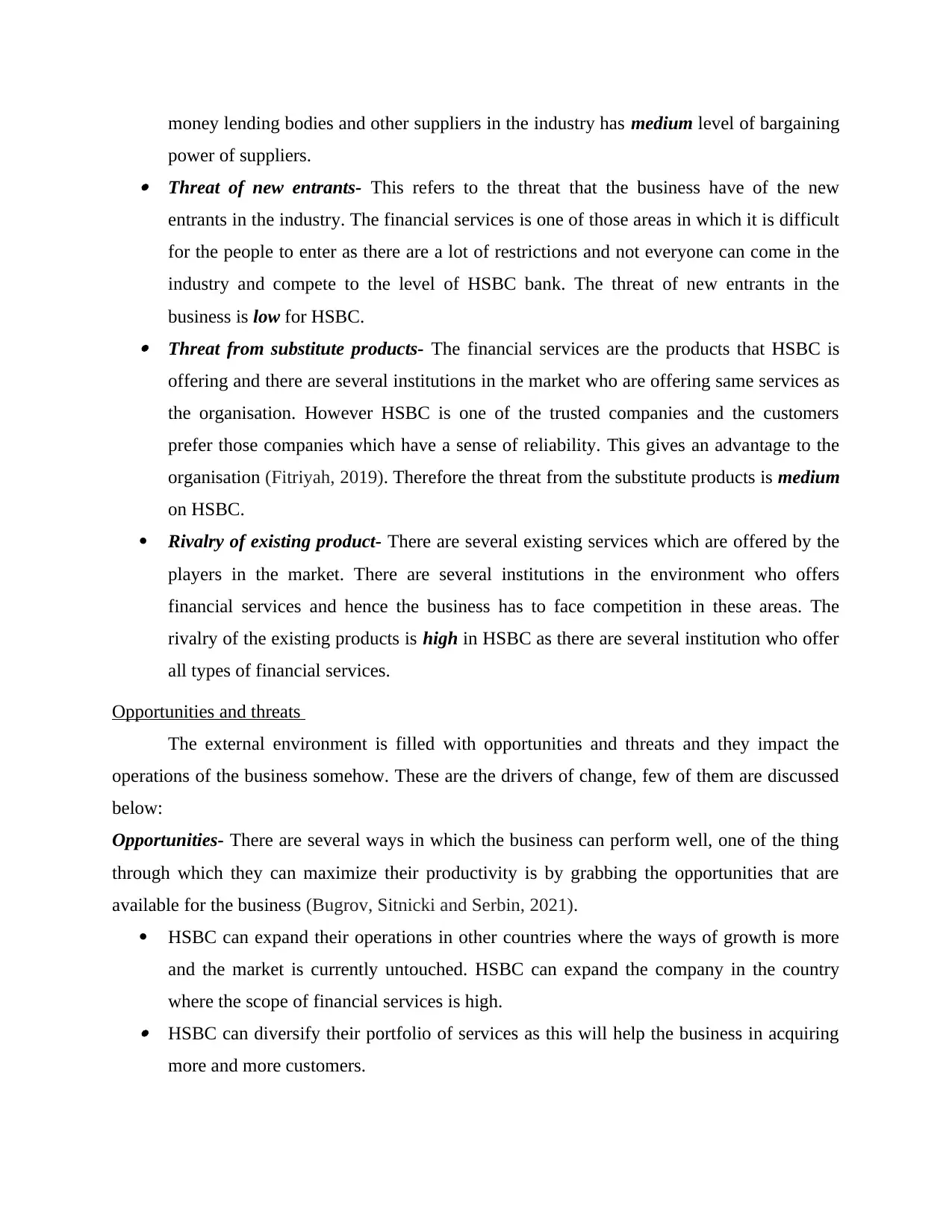
money lending bodies and other suppliers in the industry has medium level of bargaining
power of suppliers. Threat of new entrants- This refers to the threat that the business have of the new
entrants in the industry. The financial services is one of those areas in which it is difficult
for the people to enter as there are a lot of restrictions and not everyone can come in the
industry and compete to the level of HSBC bank. The threat of new entrants in the
business is low for HSBC. Threat from substitute products- The financial services are the products that HSBC is
offering and there are several institutions in the market who are offering same services as
the organisation. However HSBC is one of the trusted companies and the customers
prefer those companies which have a sense of reliability. This gives an advantage to the
organisation (Fitriyah, 2019). Therefore the threat from the substitute products is medium
on HSBC.
Rivalry of existing product- There are several existing services which are offered by the
players in the market. There are several institutions in the environment who offers
financial services and hence the business has to face competition in these areas. The
rivalry of the existing products is high in HSBC as there are several institution who offer
all types of financial services.
Opportunities and threats
The external environment is filled with opportunities and threats and they impact the
operations of the business somehow. These are the drivers of change, few of them are discussed
below:
Opportunities- There are several ways in which the business can perform well, one of the thing
through which they can maximize their productivity is by grabbing the opportunities that are
available for the business (Bugrov, Sitnicki and Serbin, 2021).
HSBC can expand their operations in other countries where the ways of growth is more
and the market is currently untouched. HSBC can expand the company in the country
where the scope of financial services is high. HSBC can diversify their portfolio of services as this will help the business in acquiring
more and more customers.
power of suppliers. Threat of new entrants- This refers to the threat that the business have of the new
entrants in the industry. The financial services is one of those areas in which it is difficult
for the people to enter as there are a lot of restrictions and not everyone can come in the
industry and compete to the level of HSBC bank. The threat of new entrants in the
business is low for HSBC. Threat from substitute products- The financial services are the products that HSBC is
offering and there are several institutions in the market who are offering same services as
the organisation. However HSBC is one of the trusted companies and the customers
prefer those companies which have a sense of reliability. This gives an advantage to the
organisation (Fitriyah, 2019). Therefore the threat from the substitute products is medium
on HSBC.
Rivalry of existing product- There are several existing services which are offered by the
players in the market. There are several institutions in the environment who offers
financial services and hence the business has to face competition in these areas. The
rivalry of the existing products is high in HSBC as there are several institution who offer
all types of financial services.
Opportunities and threats
The external environment is filled with opportunities and threats and they impact the
operations of the business somehow. These are the drivers of change, few of them are discussed
below:
Opportunities- There are several ways in which the business can perform well, one of the thing
through which they can maximize their productivity is by grabbing the opportunities that are
available for the business (Bugrov, Sitnicki and Serbin, 2021).
HSBC can expand their operations in other countries where the ways of growth is more
and the market is currently untouched. HSBC can expand the company in the country
where the scope of financial services is high. HSBC can diversify their portfolio of services as this will help the business in acquiring
more and more customers.
⊘ This is a preview!⊘
Do you want full access?
Subscribe today to unlock all pages.

Trusted by 1+ million students worldwide
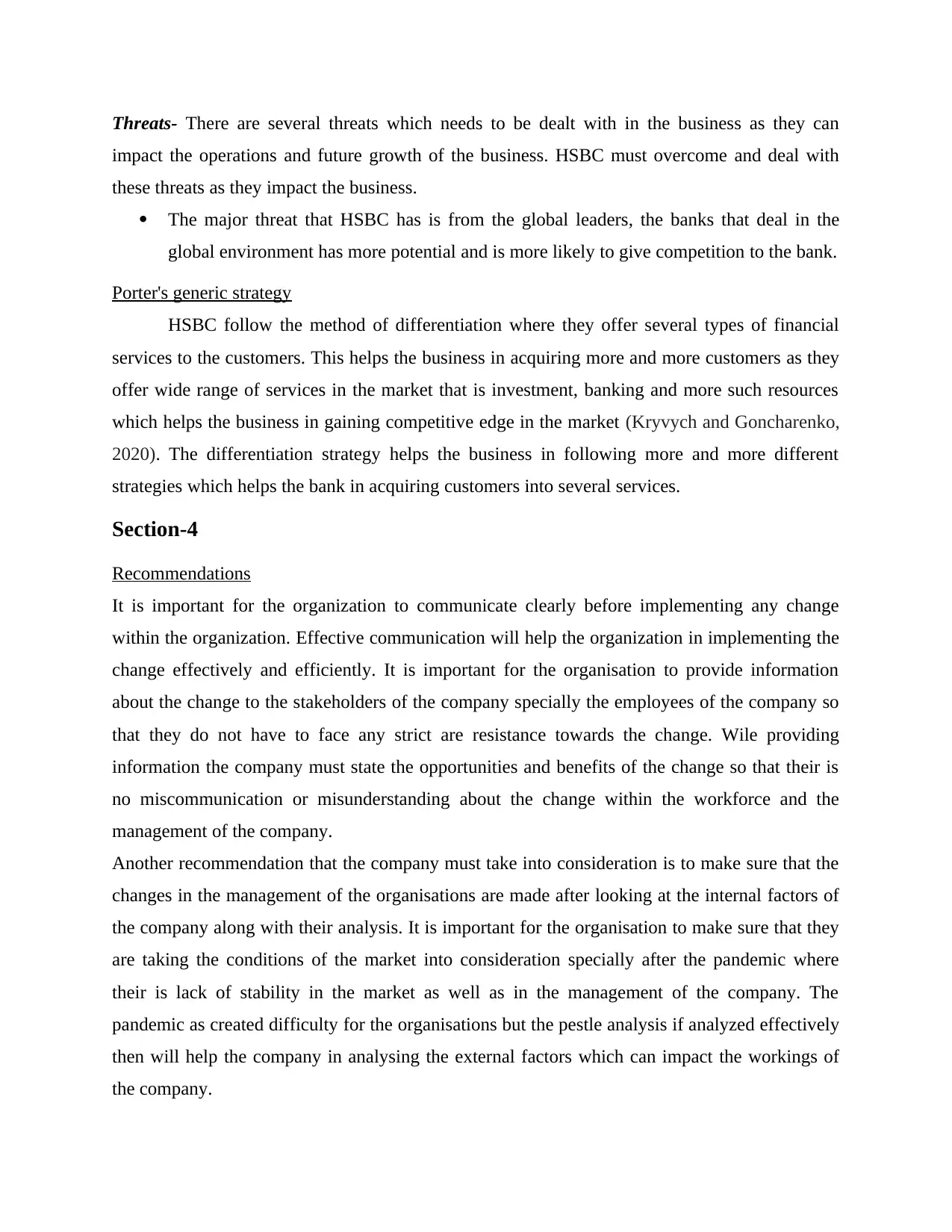
Threats- There are several threats which needs to be dealt with in the business as they can
impact the operations and future growth of the business. HSBC must overcome and deal with
these threats as they impact the business.
The major threat that HSBC has is from the global leaders, the banks that deal in the
global environment has more potential and is more likely to give competition to the bank.
Porter's generic strategy
HSBC follow the method of differentiation where they offer several types of financial
services to the customers. This helps the business in acquiring more and more customers as they
offer wide range of services in the market that is investment, banking and more such resources
which helps the business in gaining competitive edge in the market (Kryvych and Goncharenko,
2020). The differentiation strategy helps the business in following more and more different
strategies which helps the bank in acquiring customers into several services.
Section-4
Recommendations
It is important for the organization to communicate clearly before implementing any change
within the organization. Effective communication will help the organization in implementing the
change effectively and efficiently. It is important for the organisation to provide information
about the change to the stakeholders of the company specially the employees of the company so
that they do not have to face any strict are resistance towards the change. Wile providing
information the company must state the opportunities and benefits of the change so that their is
no miscommunication or misunderstanding about the change within the workforce and the
management of the company.
Another recommendation that the company must take into consideration is to make sure that the
changes in the management of the organisations are made after looking at the internal factors of
the company along with their analysis. It is important for the organisation to make sure that they
are taking the conditions of the market into consideration specially after the pandemic where
their is lack of stability in the market as well as in the management of the company. The
pandemic as created difficulty for the organisations but the pestle analysis if analyzed effectively
then will help the company in analysing the external factors which can impact the workings of
the company.
impact the operations and future growth of the business. HSBC must overcome and deal with
these threats as they impact the business.
The major threat that HSBC has is from the global leaders, the banks that deal in the
global environment has more potential and is more likely to give competition to the bank.
Porter's generic strategy
HSBC follow the method of differentiation where they offer several types of financial
services to the customers. This helps the business in acquiring more and more customers as they
offer wide range of services in the market that is investment, banking and more such resources
which helps the business in gaining competitive edge in the market (Kryvych and Goncharenko,
2020). The differentiation strategy helps the business in following more and more different
strategies which helps the bank in acquiring customers into several services.
Section-4
Recommendations
It is important for the organization to communicate clearly before implementing any change
within the organization. Effective communication will help the organization in implementing the
change effectively and efficiently. It is important for the organisation to provide information
about the change to the stakeholders of the company specially the employees of the company so
that they do not have to face any strict are resistance towards the change. Wile providing
information the company must state the opportunities and benefits of the change so that their is
no miscommunication or misunderstanding about the change within the workforce and the
management of the company.
Another recommendation that the company must take into consideration is to make sure that the
changes in the management of the organisations are made after looking at the internal factors of
the company along with their analysis. It is important for the organisation to make sure that they
are taking the conditions of the market into consideration specially after the pandemic where
their is lack of stability in the market as well as in the management of the company. The
pandemic as created difficulty for the organisations but the pestle analysis if analyzed effectively
then will help the company in analysing the external factors which can impact the workings of
the company.
Paraphrase This Document
Need a fresh take? Get an instant paraphrase of this document with our AI Paraphraser
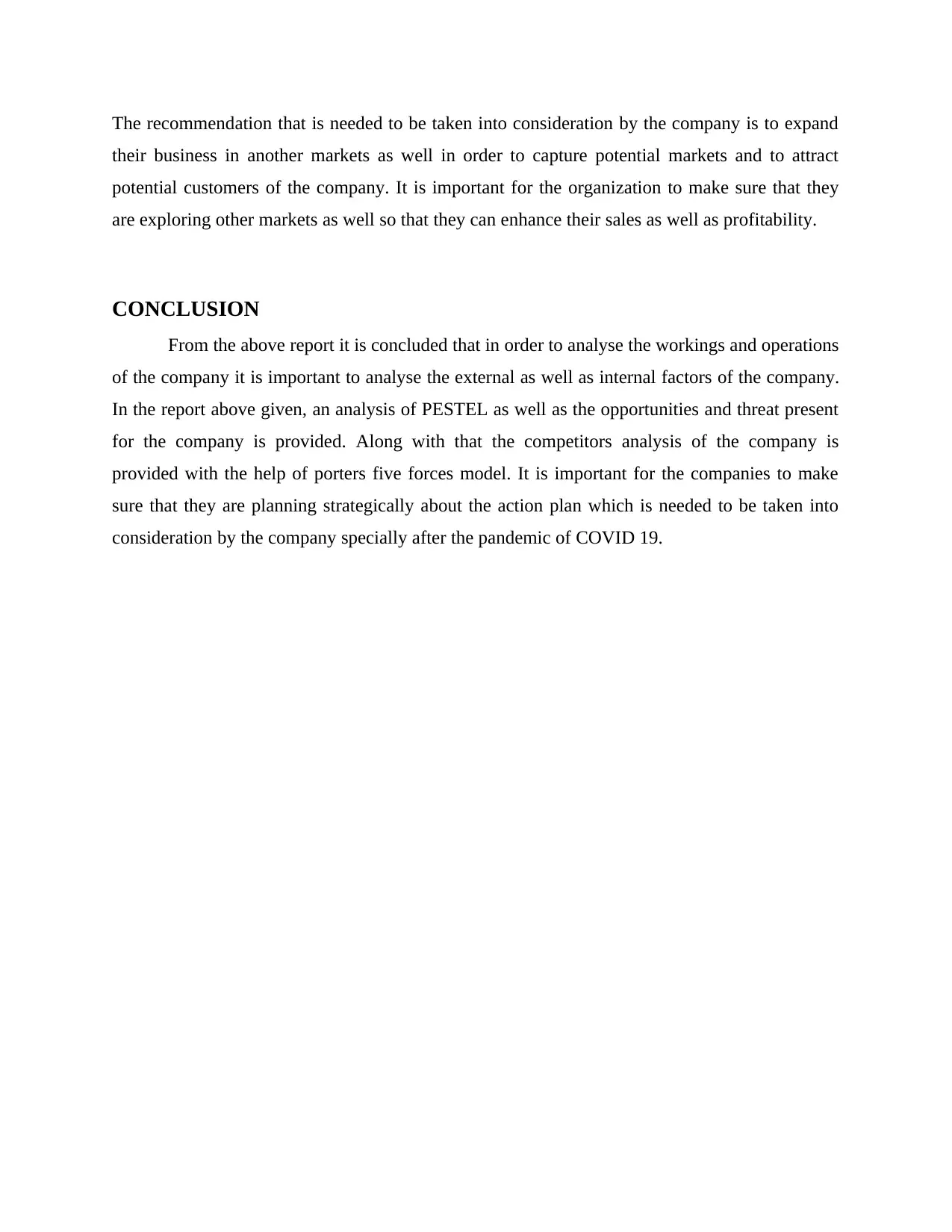
The recommendation that is needed to be taken into consideration by the company is to expand
their business in another markets as well in order to capture potential markets and to attract
potential customers of the company. It is important for the organization to make sure that they
are exploring other markets as well so that they can enhance their sales as well as profitability.
CONCLUSION
From the above report it is concluded that in order to analyse the workings and operations
of the company it is important to analyse the external as well as internal factors of the company.
In the report above given, an analysis of PESTEL as well as the opportunities and threat present
for the company is provided. Along with that the competitors analysis of the company is
provided with the help of porters five forces model. It is important for the companies to make
sure that they are planning strategically about the action plan which is needed to be taken into
consideration by the company specially after the pandemic of COVID 19.
their business in another markets as well in order to capture potential markets and to attract
potential customers of the company. It is important for the organization to make sure that they
are exploring other markets as well so that they can enhance their sales as well as profitability.
CONCLUSION
From the above report it is concluded that in order to analyse the workings and operations
of the company it is important to analyse the external as well as internal factors of the company.
In the report above given, an analysis of PESTEL as well as the opportunities and threat present
for the company is provided. Along with that the competitors analysis of the company is
provided with the help of porters five forces model. It is important for the companies to make
sure that they are planning strategically about the action plan which is needed to be taken into
consideration by the company specially after the pandemic of COVID 19.
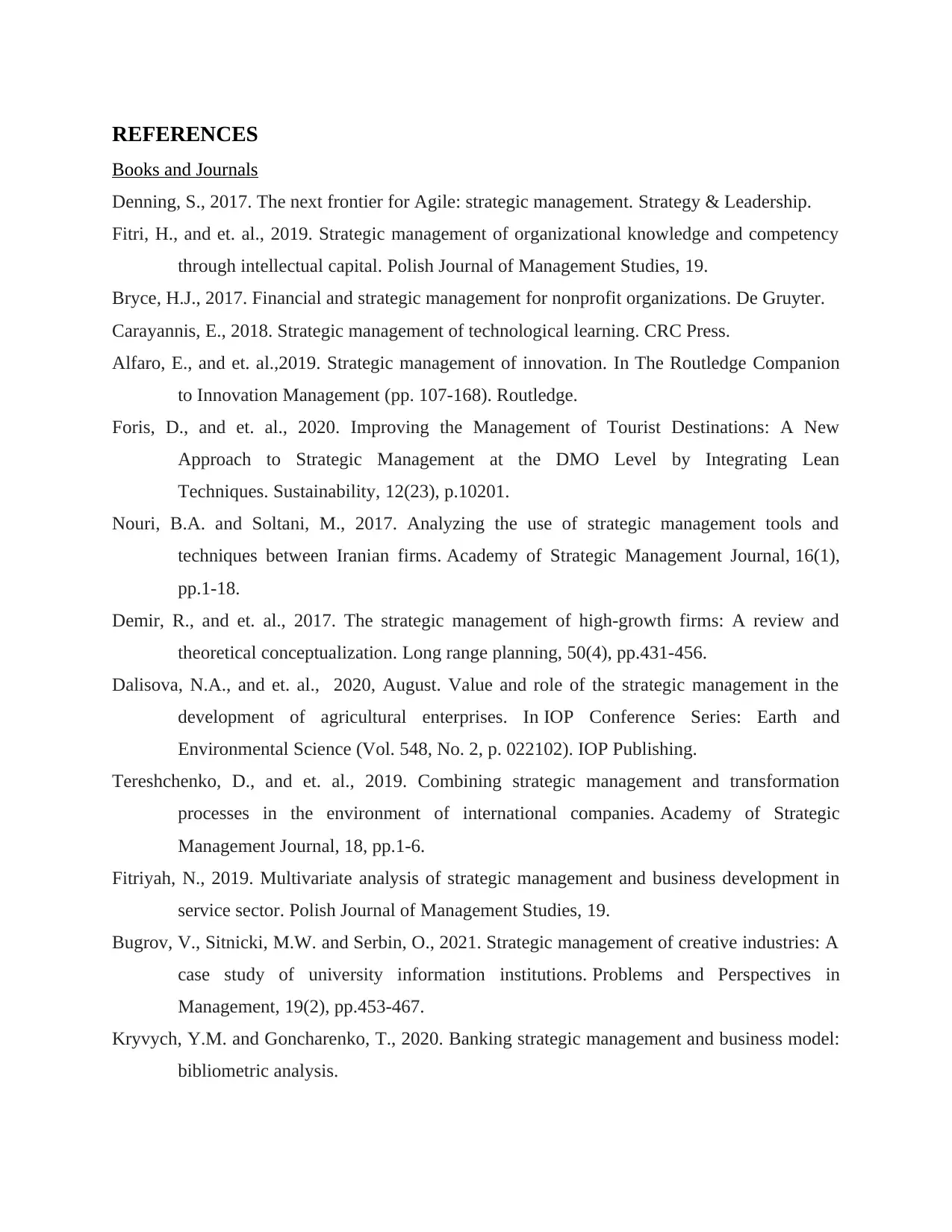
REFERENCES
Books and Journals
Denning, S., 2017. The next frontier for Agile: strategic management. Strategy & Leadership.
Fitri, H., and et. al., 2019. Strategic management of organizational knowledge and competency
through intellectual capital. Polish Journal of Management Studies, 19.
Bryce, H.J., 2017. Financial and strategic management for nonprofit organizations. De Gruyter.
Carayannis, E., 2018. Strategic management of technological learning. CRC Press.
Alfaro, E., and et. al.,2019. Strategic management of innovation. In The Routledge Companion
to Innovation Management (pp. 107-168). Routledge.
Foris, D., and et. al., 2020. Improving the Management of Tourist Destinations: A New
Approach to Strategic Management at the DMO Level by Integrating Lean
Techniques. Sustainability, 12(23), p.10201.
Nouri, B.A. and Soltani, M., 2017. Analyzing the use of strategic management tools and
techniques between Iranian firms. Academy of Strategic Management Journal, 16(1),
pp.1-18.
Demir, R., and et. al., 2017. The strategic management of high-growth firms: A review and
theoretical conceptualization. Long range planning, 50(4), pp.431-456.
Dalisova, N.A., and et. al., 2020, August. Value and role of the strategic management in the
development of agricultural enterprises. In IOP Conference Series: Earth and
Environmental Science (Vol. 548, No. 2, p. 022102). IOP Publishing.
Tereshchenko, D., and et. al., 2019. Combining strategic management and transformation
processes in the environment of international companies. Academy of Strategic
Management Journal, 18, pp.1-6.
Fitriyah, N., 2019. Multivariate analysis of strategic management and business development in
service sector. Polish Journal of Management Studies, 19.
Bugrov, V., Sitnicki, M.W. and Serbin, O., 2021. Strategic management of creative industries: A
case study of university information institutions. Problems and Perspectives in
Management, 19(2), pp.453-467.
Kryvych, Y.M. and Goncharenko, T., 2020. Banking strategic management and business model:
bibliometric analysis.
Books and Journals
Denning, S., 2017. The next frontier for Agile: strategic management. Strategy & Leadership.
Fitri, H., and et. al., 2019. Strategic management of organizational knowledge and competency
through intellectual capital. Polish Journal of Management Studies, 19.
Bryce, H.J., 2017. Financial and strategic management for nonprofit organizations. De Gruyter.
Carayannis, E., 2018. Strategic management of technological learning. CRC Press.
Alfaro, E., and et. al.,2019. Strategic management of innovation. In The Routledge Companion
to Innovation Management (pp. 107-168). Routledge.
Foris, D., and et. al., 2020. Improving the Management of Tourist Destinations: A New
Approach to Strategic Management at the DMO Level by Integrating Lean
Techniques. Sustainability, 12(23), p.10201.
Nouri, B.A. and Soltani, M., 2017. Analyzing the use of strategic management tools and
techniques between Iranian firms. Academy of Strategic Management Journal, 16(1),
pp.1-18.
Demir, R., and et. al., 2017. The strategic management of high-growth firms: A review and
theoretical conceptualization. Long range planning, 50(4), pp.431-456.
Dalisova, N.A., and et. al., 2020, August. Value and role of the strategic management in the
development of agricultural enterprises. In IOP Conference Series: Earth and
Environmental Science (Vol. 548, No. 2, p. 022102). IOP Publishing.
Tereshchenko, D., and et. al., 2019. Combining strategic management and transformation
processes in the environment of international companies. Academy of Strategic
Management Journal, 18, pp.1-6.
Fitriyah, N., 2019. Multivariate analysis of strategic management and business development in
service sector. Polish Journal of Management Studies, 19.
Bugrov, V., Sitnicki, M.W. and Serbin, O., 2021. Strategic management of creative industries: A
case study of university information institutions. Problems and Perspectives in
Management, 19(2), pp.453-467.
Kryvych, Y.M. and Goncharenko, T., 2020. Banking strategic management and business model:
bibliometric analysis.
⊘ This is a preview!⊘
Do you want full access?
Subscribe today to unlock all pages.

Trusted by 1+ million students worldwide
1 out of 13
Related Documents
Your All-in-One AI-Powered Toolkit for Academic Success.
+13062052269
info@desklib.com
Available 24*7 on WhatsApp / Email
![[object Object]](/_next/static/media/star-bottom.7253800d.svg)
Unlock your academic potential
Copyright © 2020–2025 A2Z Services. All Rights Reserved. Developed and managed by ZUCOL.





